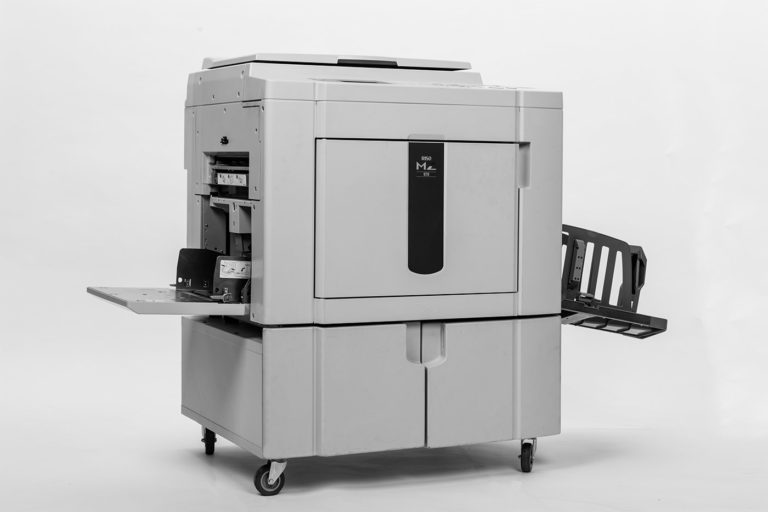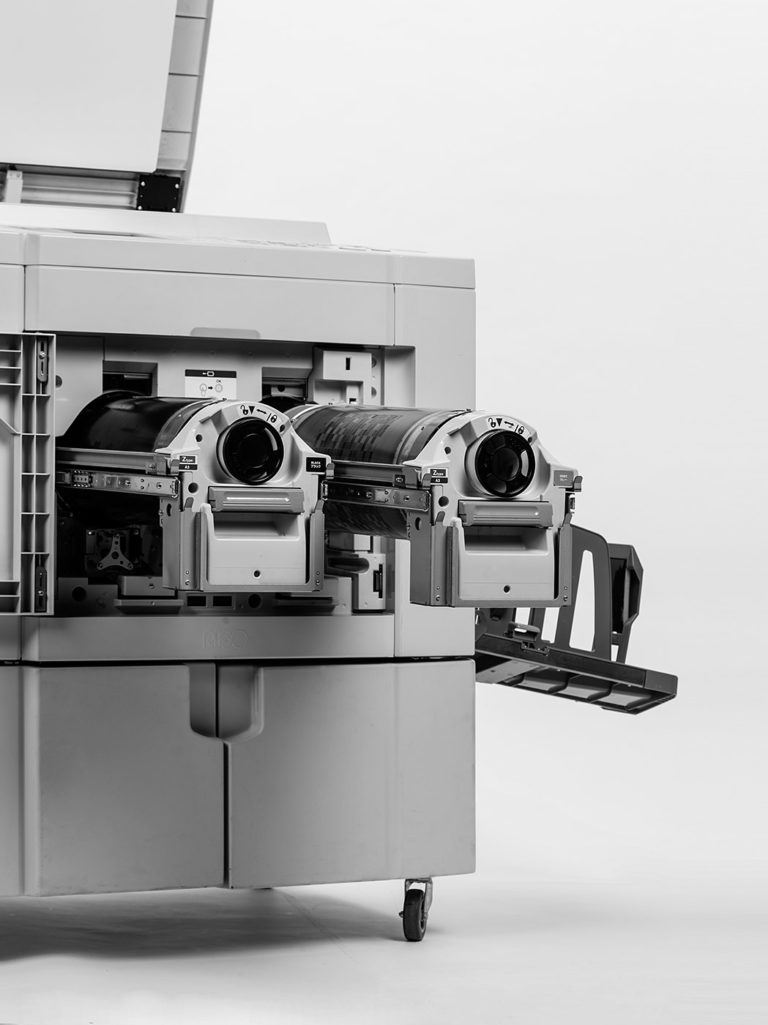이 서문에서는 리소그래피 인쇄 공정에 대해 간략하게 설명한다. 리소그래피는 디지털 복제 인쇄 방식으로 소량 인쇄에 적합하며, 친환경적이고 에너지 효율적이라는 장점이 있다.
‘리소그래피(Risography)’라는 단어는 두 개의 단어가 합쳐져 만들어졌다. 첫 번째 음절인 ‘리소(Riso)’는 일본어 ‘理想 1 (りそう, 이상적)’에서 유래했으며, 두 번째 음절인 ‘-그래피 2 (-graphy)’는 그리스어 ‘graphē’ 또는 ‘graphía’에서 파생된 것으로 ‘쓰다, 그리다’라는 뜻을 가지고 있다. 따라서 리소그래프(risograph)는 자유롭게 번역하면 “이상적인 프린터”라고 할 수 있다.
겉으로 볼 때 리소그래프는 복사기나 디지털 프린터와 크기가 비슷하지만, 가정용 탁상형 기계는 없다. MZ 시리즈의 표준 장비는 가로 1010mm, 세로 725mm, 높이 730mm이며 3 무게는 168kg이다. 용지 공급 및 배출 장치 같은 구성품을 펼치면, 프린터는 폭 약 1600mm의 공간을 차지한다. 리소그래프를 제대로 작동시키려면 컬러 카트리지 잉크와 마스터 원지 같은 소모품이 필요하다.
리소그래프는 노광된 스텐실을 사용하여 원본의 양각 복사본을 만든다. 인쇄 과정은 스크린 인쇄와 가장 유사해 보이지만, 특징적인 속성 때문에 오프셋 인쇄에도 가깝다. 하지만 리소그래프는 큰 비용 없이도 독창적인 결과물을 만들어낼 수 있어 궁극적으로 디지털 인쇄에 속한다고 볼 수 있다.
언뜻 보기에 마스터 원본을 제작한다는 점에서 스크린 인쇄 방식과 가장 유사하다. 하지만 리소그래피는 (열로 노광하는 폴리에스터 수지 필름으로 된) 리소 마스터 필름을 만들기 훨씬 쉽고 인쇄도 더 빠르다는 장점이 있다. 산업용 스크린 인쇄에서도 필름 제작, 스크린 코팅, 스크린 노광, 수세, 그리고 마지막으로 인쇄 테이블에 세팅하는 등 시간이 많이 걸리는 작업 단계를 거쳐야 한다. 반면, 숙련된 리소 전문가는 인쇄용 PDF를 설정하고 인쇄를 시작하기까지 단 5분밖에 걸리지 않는다.
열로 노광된 마스터 필름은 리소그래프의 인쇄 드럼에 완전 자동으로 장착된다. 이후 드럼 안에 있는 카트리지에서 잉크가 공급되어 마스터 필름이 잉크로 채워진다.
용지는 분당 최대 150매의 매우 빠른 속도로 공급된다. 노광된 마스터 필름의 이미지는 윤전 방식으로 용지에 양각으로 인쇄되며, 프린터 모델에 따라 한 번의 인쇄 과정에서 한 가지 혹은 두 가지 색상으로 인쇄할 수 있다.
 1
리소그래프 MZ 770 E, 용지 공급 및 배출 장치를 펼친 상태
1
리소그래프 MZ 770 E, 용지 공급 및 배출 장치를 펼친 상태
 2
리소그래프의 컬러 드럼, 드럼을 빼낸 상태
2
리소그래프의 컬러 드럼, 드럼을 빼낸 상태
 3
마스터 제판 장치
3
마스터 제판 장치
표준 레이저 프린터가 5분 동안 약 100페이지를 인쇄하는 동안 리소그래프 MZ 1070은 최대 900페이지를 인쇄할 수 있다.
또한, 리소그래프는 모티프를 재현하기 위해 “진짜”이고 훨씬 더 강렬한 잉크를 다양한 특수 색상으로 사용한다. 즉, 20가지 이상의 표준화된 색상 4 또는 50가지 특수 색상 중 두 가지 색상으로 A4 또는 A3 용지에 인쇄할 수 있다. 2014년부터는 최대 DIN A2 인쇄 범위를 가진 리소 프린터도 출시되었다. 일반적인 장비는 최대 210g/sqm의 용지에 인쇄할 수 있으며, 다소 “이색적인” RISO A2 모델은 최대 120g/sqm 용지에 인쇄 가능하다 5.
리소그래피는 다른 인쇄 기술보다 훨씬 더 친환경적이다. 리소 잉크는 콩기름으로 만들어지며, 휘발성 유기 화합물(VOCs) 함량이 낮아 유해 물질 배출로 인한 대기 오염이 적다.6 이는 건강에도 훨씬 이롭다는 의미다. 이러한 특성 덕분에 리소 인쇄물은 다른 인쇄 방식과는 확연히 다른 독특한 외관을 가진다. 사용된 특별한 색상, 풍부한 색감, 그리고 흥미로운 인쇄 이미지가 그 특징이다. 보조색이나 삼차색을 얻기 위해 CMYK 4색 척도를 사용할 필요가 없다. 대신, 제조사의 컬러 팔레트를 사용하여 원하는 색조를 해당 색상표의 색상과 동일하게 재현한다. 15매 이상의 인쇄물부터는 리소그래프가 레이저 또는 잉크젯 프린터보다 저렴하다. 7
리소 인쇄 방식의 속도 외에도, 스크리닝, 스크린 각도, 색상 등 공정의 여러 중요한 요소를 직접 설정하고 조절할 수 있다. 이는 인쇄 과정에 실험적인 개입을 가능하게 한다.
따라서 단순히 PDF 파일을 USB 연결을 통해 인쇄기로 보내는 것만 가능한 것이 아니다. 모든 최신 리소그래프는 스캔 패드를 통해 인쇄 이미지를 재현할 수 있는 기능을 갖추고 있다. 컴퓨터에서 파일을 전송하든 스캐너로 스케치를 로드하든, 파일의 매끄럽고 완벽한 미학과 디지털 인쇄물의 균일성은 항상 기계 자체의 개성을 발전시키는 데 기여한다.
대신 사용자는 리소 인쇄를 통해 대부분 거칠면서도 때로는 지저분하지만, 무엇보다도 장인 정신이 깃든 아름다움을 의도적으로 구현할 수 있다. 색 분리 간에 약간의 판 맞춤 오차가 있거나, 용지 흡입 휠이 갓 인쇄된 용지 위에서 잉크를 문질러 리소 인쇄물의 독특한 외관에 기여하는 것은 흔한 일이다. 또한, 프린터와 인쇄 공정은 다양한 미세 조정을 가능하게 한다. 이로 인해 개성을 추구하는 사용자는 수없이 많은, 고정되지 않은 방식으로 리소 인쇄를 활용할 수 있다. 지금까지 리소그래프 사용자는 여전히 자신이 만든 작품의 아름다움을 추구하는 소수의 특별한 그룹에 속한다. 바로 이것이 성장하는 리소 운동의 가치다.
장비, 마스터 원지, 잉크의 낮은 구매 비용 덕분에 예술가, 디자인 스튜디오, 소규모 출판사들이 리소그래프를 통해 직접 인쇄물을 제작하려는 움직임은 충분히 이해할 만하다. 이는 일본 제조사가 본래 의도했던 것보다 더 넓은 사용자층으로 확산되고 있다. 원래 리소 프린터는 학교, 교회, 정당 조직 등을 주 대상으로 한다. 또한, 40~70%의 높은 습도 허용 범위 8 덕분에 레이저 프린터에는 부적합한 환경 9 에서도 장비를 사용할 수 있어, 기후적으로 어려운 조건에서의 사용도 드물지 않다.
하지만 리소그래피에도 단점은 있다. 디지털 인쇄에서처럼 토너를 열로 고정하는 방식이 아니어서, 잉크 적용량에 따라 색상이 전혀 마르지 않을 수도 있다. 또한, 잉크젯이나 디지털 인쇄(4색 또는 5색)와 비교했을 때 인쇄된 이미지가 매우 거칠게 보여, 아주 미세한 그리드를 사용하는 정교한 작업에는 매우 부적합하다. 앞서 언급했듯이, 리소는 인쇄된 이미지의 완벽한 복사본을 만들어낼 수 없으며, 각 인쇄물마다 모티프가 조금씩 다르게 표현된다. 이는 전체적으로 현대의 DIY(Do-It-Yourself) 느낌과 빈티지한 매력 사이의 공존적인 분위기를 부여한다. 이는 적용 분야에 따라 우연한 매력이 될 수도 있고 단점이 될 수도 있다.
안타깝게도 등사판 인쇄기나 리소그래프와 같은 스텐실 프린터가 서서히 구식이 되어간다는 느낌이 커지고 있다. 독일어권 국가의 여러 리소그래프 판매점과 논의한 결과, 여기서 언급된 매트릭스(리소) 장비들이 약정 기간이 만료된 후에는 더 새로운 장비들로 교체되고 있음이 드러났다. 2009년부터 제조사는 ComColor 표준에 투자하고 있다. 이 장비들은 디지털 프린터의 다색 토너 시스템과 유사하므로, 이 책에서는 더 이상 자세히 다루지 않을 것이다.
이 책에서는 리소 인쇄 과정의 다양한 측면에 주목하며, 인쇄물 제작에 대한 도움, 색 분리 준비에 대한 통찰력을 제공한다. 또한, 올바른 용지 선택 방법을 설명하고 인쇄 및 후가공을 위한 팁을 제공한다. 이 텍스트들과 함께, 인쇄된 간행물 속에서 테스트 인쇄물을 통해 인쇄 이미지와 색상의 특징을 폭넓게 파악할 수 있는 독립형 소책자가 동봉되어 있다.
 1
1
 2
2
 1
1
 2
2